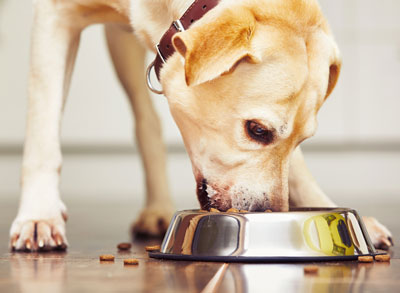Why Does My Dog Bring Up Food After Eating?

Does this happen in your home: your dog eats his food, then a few minutes later, you see him taking an unmistakable posture. Sure enough, you rush over to find a pile of undigested kibble on your white rug.
Again.
Your dog simply walks off and lies down, looking perfectly happy and comfortable. Or, worse yet, he attempts to re-consume the mess.
Why Does My Dog Bring up Food Right Away After Eating?
There are a multitude of reasons for dogs to vomit or regurgitate. Regurgitation is when food comes up without the involvement of contraction of the stomach muscles. Vomiting is when the stomach muscles contract and the stomach contents come back up.
One common reason for dogs to have undigested food come back up immediately after eating is that the food has been taken in too fast.
When a dog eats fast, kibbles are often ingested without being chewed. Also, large amounts of air are usually swallowed. Both of these can trigger either regurgitation or vomiting.
Always check with your veterinarian if your dog is vomiting or regurgitating. Don't assume the problem is that he's eating too fast without going over it with the doctor. There are many causes, and some of them require medical intervention.
Why Do Some Dogs Eat So Fast?
Dogs may eat fast because they are anxious about the food. They may have learned when they were still with their litter that they must eat fast or risk not getting any food.
Dogs may be genetically predisposed to eat quickly due to their wild ancestors needing to get what they could quickly when a kill was made. Dogs can be innately compelled to guard their food, which may mean being aggressive when other dogs or people approach their food or eating it as quickly as possible.
Some dogs may just have a personality that lends itself to eating fast. Maybe they want to get back to playing as soon as they can.
Dogs may gulp their food if they are allowed to be very hungry before mealtime. This is sometimes the case with dogs that are fed once a day.
Should I Worry About My Dog Eating Too Fast?
While the mess of undigested food being brought up is an unpleasant nuisance, there are other concerning reasons to work on getting your dog to eat more slowly.
- Deep-chested dogs that eat fast and take in lots of air are at risk for developing life-threatening GDV, a bloating and twisting of the stomach.
- Your dog may choke on his food if he's eating too fast and not chewing well. This may occur while it's going down or when it's coming back up.
-
If your dog is food guarding, it could lead to aggression, which may be dangerous for people or other pets in your home.
How Can I Get My Dog to Eat Slower?
Here are some strategies for teaching your dog to eat more slowly, reducing the risks associated with eating fast and hopefully decreasing the piles of undigested food on your floor.
- Use a special bowl that is meant to be a slow-feeder. These bowls usually have one or more dome shapes in the center which causes kibble to separate around them. The dog must maneuver to get in the remaining space and get food out, eliminating his ability to scarf down large mouthfuls of food at once. We like this one: Stainless Steel Brake-Fast Bowl.
- Use a puzzle feeder instead of a bowl. These release a few kibbles of food at a time as your dog manipulates them. Not only is this good for slowing your fast eater down, but it's great mental enrichment, too.
- Break your dog's meals into small, more frequent ones. If your schedule allows, feeding your dog smaller amounts more often can decrease the gobbling if it's due to being hungry.
- Use your dog's mealtime kibble for a training session. You can use the kibble that you would normally give your dog for a meal to conduct a training session instead. The kibble can be used as positive reinforcement treats. Not only will this decrease the risks associated with fast eating, but it will provide bonding for the two of you and enrichment for your dog.
- Hide your dog's food. This is another great way to stimulate your dog mentally while slowing down his eating patterns. Divide your dog's meal into handfuls and hide them around a room or the home, then allow him to "hunt" them all down and eat a bit at a time.
You May Also Like These Articles:
Dog Training Tips: Using Treats Properly
Dog Weight Loss: Tips For Helping Your Dog Lose Weight
10 Ways You Could Be Shortening Your Dog's Life - Slideshow
What Should You Do If Your Dog's Food Is Recalled?
Keeping Your Dog Active While You're Away
Dog Is Crushed That Owner Ate All the Food: VIDEO
Disclaimer: This website is not intended to replace professional consultation, diagnosis, or treatment by a licensed veterinarian. If you require any veterinary related advice, contact your veterinarian promptly. Information at DogHealth.com is exclusively of a general reference nature. Do not disregard veterinary advice or delay treatment as a result of accessing information at this site. Just Answer is an external service not affiliated with DogHealth.com.
Notice: Ask-a-Vet is an affiliated service for those who wish to speak with a veterinary professional about their pet's specific condition. Initially, a bot will ask questions to determine the general nature of your concern. Then, you will be transferred to a human. There is a charge for the service if you choose to connect to a veterinarian. Ask-a-Vet is not manned by the staff or owners of DogHealth.com, and the advice given should not delay or replace a visit to your veterinarian.



